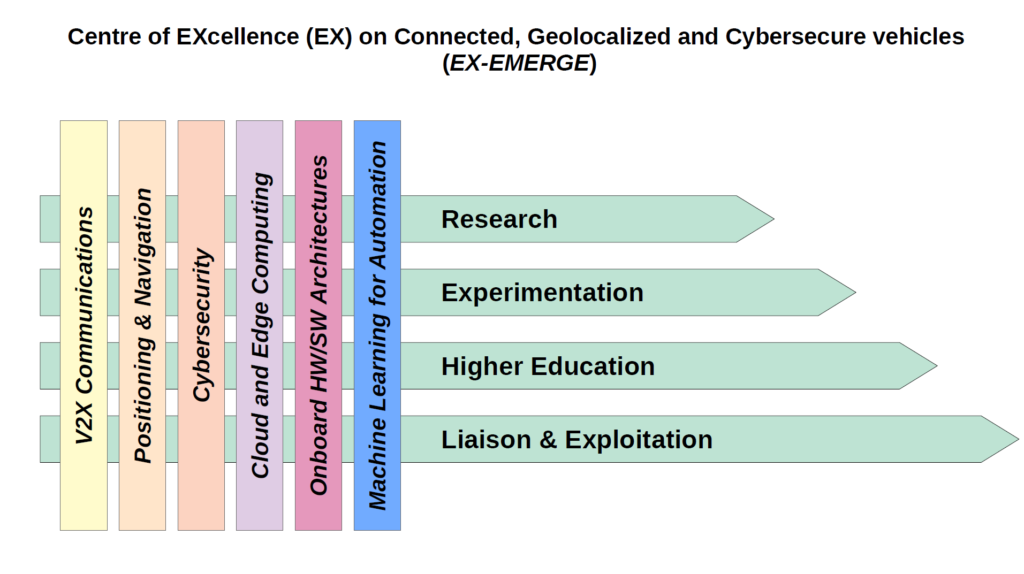
The Centre activities follows four main guidelines: research, experimentation, higher education and liaison with other projects as well as exploitation of the outcomes.
The founding pillars of our activities are four research areas, recognized by the research and industrial communities as the key enabling technologies (KET) for the future autonomous and connected vehicles: the capability of transferring data both with other road users and with the infrastructure (V2X communications), the knowledge of exact position in the space along with the ability to safely navigate between two locations (Positioning and Navigation), the application of Cybersecurity techniques over the whole system and the integration of control theory and Machine Learning for Automation tasks.
The Centre also investigates the cloud paradigm as a support to the world of the ITSs, taking also in account the benefits of having the computational nodes as close as possible to the network users, i.e. Mobile Edge Computing (MEC). The last pillar concerns the design of Hardware and Software Architectures for the onboard systems, following an integrated approach that comprises all the vehicle components and is applied since the beginning of vehicle design process.
The research activities cover, with a cross-disciplinary approach, the topics related to the six pillar described before, insisting on the emerging technologies in terms of connectivity (V2X, 3-4-5G/LTE), positioning (multi-costellation and multi-frequency) and cybersecurity (intrusion prevention, cryptographic key management, anti-jamming). The final goal is creating distributed solutions for traffic flows management at system level and self-determination of driving actions by every single vehicle. Envisioning a “smart” evolution of the ITS environment, the investigated solutions are expected to improve the flexibility and the performance in the passenger transportation, and also enable the vehicles to collaboratively interact and provide support during critical operations actuating an automatic coordination to cooperate with emergency vehicles. To reach these goals advanced navigation features will be investigated, as well as the use of Artificial Intelligence and control theoretic techniques, to derive predictive models of risk situations and traffic congestions.
The Centre also promotes ICT research for the development of advanced scientific knowledge on the technological equipment of the future vehicles, with main focus on vehicular mobility systems.
Due to the extreme importance of the research topics described above, both for the academy and the industry, the Centre aims to transfer the acquired knowledge and to train new resources through an higher education program. This will be possible via:
- enrolment and training of students in the ITS domain at both master and doctoral level;
- openings of academic positions in the ITS field;
- training of cutting-edge professional profiles in the following fields: 5G communications and their evolution, on-board and back-end software architectures, positioning and navigation, cybersecurity, machine learning for automation and, more in general, ICT systems for the mobility of the future;
A relevant amount of activities of the Centre will concern the experimentation of ITS solutions subject of the envisioned research activities. The main expected result is the creation of advanced laboratories and the setup of a test-bed that resemble the real world, provided with a telecommunication infrastructure and some real commercial vehicles. In order to cover a wide set of conditions, the aforementioned test-bed will be deployed as:
- a testing laboratory,
- a car testing track in a controlled environment,
- a set of integrated testing solutions with the urban environment, that will result in a “city living-testbed”.
The Centre will acquire the needed laboratory equipment, the devices and the HW/SW platforms for both indoor and outdoor testing, and will also prepare five light trucks for the performance analysis and the validation of the solutions proposed by the Centre and by the partners. This will enable to test advanced smart mobility applications and services, with particular focus on the dual-use vehicles (commercial and emergency) in a urban environment.
One of the missions of the Centre is to develop prototypes of on-board ICT platforms for advanced smart mobility services, taking in account the interaction between the road and railway ecosystems according to a modern inter-modal approach for the future road infrastructures.
The liaison and exploitation activities will constitute the founding elements of the Excellence Centre to promote national and international collaborations, to facilitate the transfer of the acquired technology and to guarantee the access to additional research fundings. The Centre has a strong liaison with the EMERGE project and, due to the cutting-edge research topics faced, has the ambition to become a reference institution for similar projects in the ITS and Space domains.
Among others, the following tasks will lead the liaison and exploitation activities:
- accreditation of the Centre at European level with research institutions and agencies, e.g. ESA (European Space Agency) and GSA (Galileo Space Authority);
- cooperation with the local aerospace/ICT domain in a global network;
- intensification of the relationship with the major industrial reality in the automotive aream and more generally with the transportation segment to achieve stable partnerships;
- join the national transport cluster;
- strengthen of the national and international research collaborations (e.g. University of Roma Tre, University of Stanford, University of Nottingham, DLR, University of Pennsylvania and many others).

